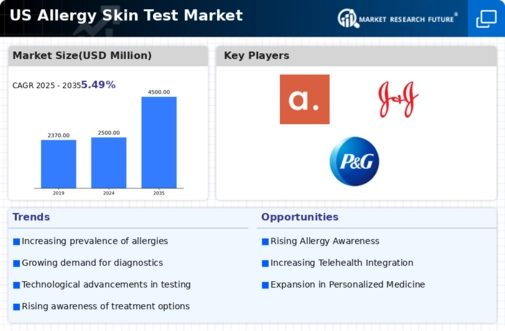Rising Allergy Incidence Rates
The allergy skin-test market is experiencing growth due to the increasing incidence of allergic conditions in the US. Recent data indicates that approximately 30% of adults and 40% of children are affected by allergies, leading to a heightened demand for effective diagnostic tools. This trend is likely to drive the adoption of skin testing as a primary method for identifying allergens. As healthcare providers seek to address this growing public health concern, the allergy skin-test market is expected to expand significantly. The rising prevalence of conditions such as asthma, hay fever, and food allergies necessitates accurate testing, which in turn fuels market growth. Furthermore, the increasing awareness of the importance of early diagnosis and management of allergies contributes to the overall demand for skin testing solutions.
Increased Healthcare Expenditure
Increased healthcare expenditure in the US is contributing to the growth of the allergy skin-test market. As healthcare budgets expand, there is a greater allocation of resources towards allergy diagnosis and management. This trend is evident in both public and private sectors, where investments in allergy testing technologies and services are on the rise. The growing recognition of the economic burden associated with untreated allergies is prompting stakeholders to prioritize effective diagnostic solutions. Consequently, the allergy skin-test market is likely to benefit from enhanced funding and support for allergy-related healthcare initiatives. Additionally, the expansion of insurance coverage for allergy testing services further facilitates access to these essential diagnostic tools, thereby driving market growth. The overall increase in healthcare spending is expected to create a favorable environment for the allergy skin-test market.
Rising Public Awareness of Allergies
Rising public awareness of allergies is a key driver for the allergy skin-test market. Educational campaigns and advocacy efforts have significantly increased knowledge about allergic conditions and their management. As individuals become more informed about the symptoms and risks associated with allergies, there is a growing demand for diagnostic testing. This heightened awareness encourages patients to seek medical advice and undergo skin testing to identify specific allergens. Furthermore, the proliferation of information through digital platforms and social media has empowered patients to take proactive steps in managing their allergies. The allergy skin-test market is likely to see continued growth as public awareness initiatives persist, leading to increased testing rates and improved patient outcomes. This trend underscores the importance of education in driving demand for allergy testing solutions.
Growing Demand for Personalized Medicine
The trend towards personalized medicine is significantly impacting the allergy skin-test market. Patients are increasingly seeking tailored treatment options that address their specific allergic conditions. This shift is prompting healthcare providers to utilize skin testing as a means of developing individualized management plans. The ability to identify specific allergens allows for more effective treatment strategies, which enhances patient outcomes. As the healthcare landscape evolves, the emphasis on personalized approaches is likely to drive the demand for allergy skin testing. Furthermore, the market is expected to grow as patients become more engaged in their healthcare decisions, seeking tests that provide precise information about their allergies. This trend aligns with the broader movement towards patient-centered care, which is reshaping the allergy skin-test market.
Innovations in Allergy Testing Technologies
Innovations in allergy testing technologies are transforming the allergy skin-test market. The introduction of advanced testing methods, such as molecular diagnostics and high-throughput screening, enhances the accuracy and efficiency of allergy identification. These technological advancements allow for the detection of a broader range of allergens, which is crucial given the diverse nature of allergic reactions. The market is witnessing a shift towards more user-friendly and rapid testing solutions, which appeal to both healthcare providers and patients. As a result, the allergy skin-test market is likely to benefit from increased adoption rates. Moreover, the integration of digital health technologies, such as mobile applications for tracking allergy symptoms, further supports the growth of this market segment. The ongoing research and development efforts in this area suggest a promising future for innovative allergy testing solutions.














Leave a Comment